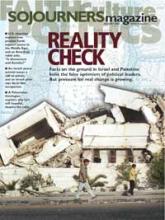Palestinian theologian Naim Ateek was asked recently if there was any hope for a nonviolent solution to the conflict between Israelis and Palestinians. Ateek, who is profiled in this issue, responded with a long list of reasons why years of nonviolent efforts by many in the region have been extremely difficult to organize and have met with limited success. And yet, Ateek concluded, nonviolence is "our only hope."
We have seen what violence has done in the Middle East. We have seen the pictures of the horrible aftermath of suicide bombings in Tel Aviv and Jerusalem. We have seen marketplaces filled with the dead and injured, seen the buses ripped apart by explosions set off by those whose weapons are carnage and terror. We have seen entire neighborhoods turned to rubble by an occupying army bent on consolidating control. We have seen the slow-boiling misery in Palestinian refugee camps, farms and homes bulldozed regardless of who was caught beneath the blade, and whole families killed by "targeted" attacks by Israeli jets. We have seen the results of violence.
But most North Americans really haven’t understood what happens on the ground. The U.S. media paint a picture of the region that implies a rough equivalency between the Palestinians and Israel: Violence on one side is met with violence on the other; a bomb explodes here or there; little context is given.
Read the Full Article
